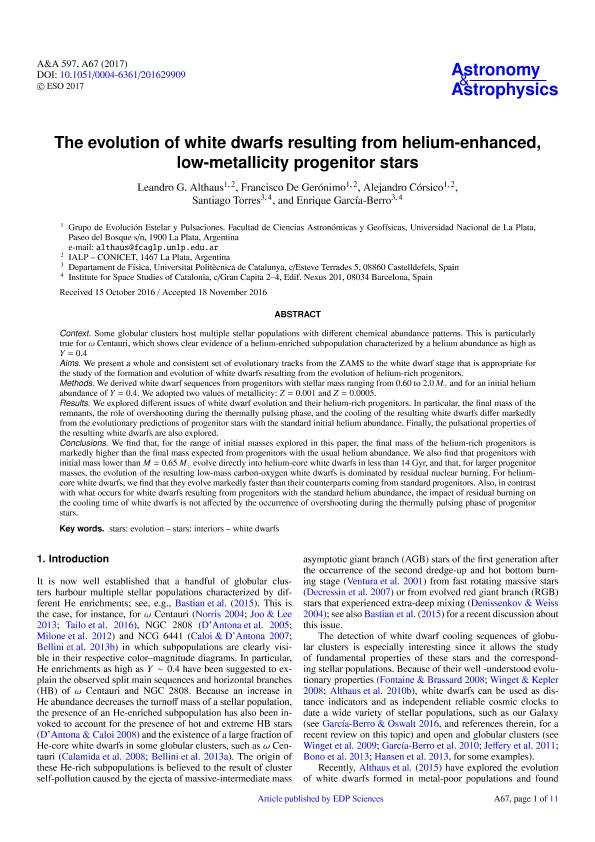Artículo
The evolution of white dwarfs resulting from helium-enhanced, low-metallicity progenitor stars
Althaus, Leandro Gabriel ; de Gerónimo, Francisco César
; de Gerónimo, Francisco César ; Corsico, Alejandro Hugo
; Corsico, Alejandro Hugo ; Torres, Santiago; García Berro, Enrique
; Torres, Santiago; García Berro, Enrique
 ; de Gerónimo, Francisco César
; de Gerónimo, Francisco César ; Corsico, Alejandro Hugo
; Corsico, Alejandro Hugo ; Torres, Santiago; García Berro, Enrique
; Torres, Santiago; García Berro, Enrique
Fecha de publicación:
01/2017
Editorial:
EDP Sciences
Revista:
Astronomy and Astrophysics
ISSN:
0004-6361
Idioma:
Inglés
Tipo de recurso:
Artículo publicado
Clasificación temática:
Resumen
Context. Some globular clusters host multiple stellar populations with different chemical abundance patterns. This is particularly true for ω Centauri, which shows clear evidence of a helium-enriched subpopulation characterized by a helium abundance as high as Y = 0.4Aims. We present a whole and consistent set of evolutionary tracks from the ZAMS to the white dwarf stage that is appropriate for the study of the formation and evolution of white dwarfs resulting from the evolution of helium-rich progenitors.Methods. We derived white dwarf sequences from progenitors with stellar mass ranging from 0.60 to 2.0 M⊙ and for an initial helium abundance of Y = 0.4. We adopted two values of metallicity: Z = 0.001 and Z = 0.0005.Results. We explored different issues of white dwarf evolution and their helium-rich progenitors. In particular, the final mass of the remnants, the role of overshooting during the thermally pulsing phase, and the cooling of the resulting white dwarfs differ markedly from the evolutionary predictions of progenitor stars with the standard initial helium abundance. Finally, the pulsational properties of the resulting white dwarfs are also explored.Conclusions. We find that, for the range of initial masses explored in this paper, the final mass of the helium-rich progenitors is markedly higher than the final mass expected from progenitors with the usual helium abundance. We also find that progenitors with initial mass lower than M ≃ 0.65 M⊙ evolve directly into helium-core white dwarfs in less than 14 Gyr, and that, for larger progenitor masses, the evolution of the resulting low-mass carbon-oxygen white dwarfs is dominated by residual nuclear burning. For helium-core white dwarfs, we find that they evolve markedly faster than their counterparts coming from standard progenitors. Also, in contrast with what occurs for white dwarfs resulting from progenitors with the standard helium abundance, the impact of residual burning on the cooling time of white dwarfs is not affected by the occurrence of overshooting during the thermally pulsing phase of progenitor stars.
Palabras clave:
Evolution of Stars
,
Interior Stars
,
White Dwarfs
Archivos asociados
Licencia
Identificadores
Colecciones
Articulos(IALP)
Articulos de INST.DE ASTROFISICA LA PLATA
Articulos de INST.DE ASTROFISICA LA PLATA
Citación
Althaus, Leandro Gabriel; de Gerónimo, Francisco César; Corsico, Alejandro Hugo; Torres, Santiago; García Berro, Enrique; The evolution of white dwarfs resulting from helium-enhanced, low-metallicity progenitor stars; EDP Sciences; Astronomy and Astrophysics; 597; 1-2017; A67
Compartir
Altmétricas



